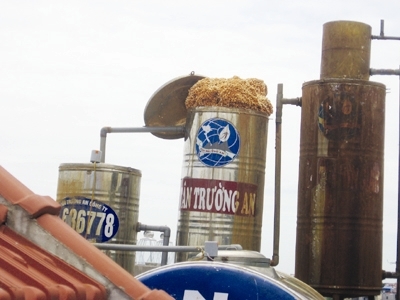Underground water is degrading in quality, which is a big problem for nearly all water utilization projects.
 |
According to a recent survey conducted by the Center for Programming and Surveying Water Resources under the Ministry of Natural Resources and the Environment, among the fields which use underground water, the underground water for household use accounts for a small proportion, just two percent, while the water quality is very low.
In the areas of Cao Bang and Quang Ninh provinces, a part of the area neighbors the sea, therefore, the coastal water is always salty. In the area of Ha Giang and Tuyen Quang, underground water here is light with very small content of trace elements, which should not be used eating or drinking. Meanwhile, in Lao Cai and Hoa Binh, underground water has a low content of iodine.
In the north of the central region, the biggest problem can be seen in the water of the lowland and the coastal area of Thanh Hoa. The water here has high content of iron, while the content of derived organic compound is also higher than that in the midland and mountainous areas.
In the coastal areas of the central region, water has high mineralization. Therefore, the supply of drinking water is limited. In the east of the southern region, the pH level in water is generally low with weak acid reaction. Therefore, the water cannot be used for household use if there is no solution to treat the water to increase the pH level.
In the Mekong Delta, the iron content in water also exceeds the allowed level. In some areas, experts can see influences from the saltwater intrusion through the water extraction wells.
The biggest underground water problems can be seen in the lowland of the northern region. In some areas, the pH level is too low while the iron level is too high. In other areas, the water has become salty, while the microelement component level is lower than the standard. Meanwhile, the total degree of mineralization is too high somewhere and too low elsewhere. In Hanoi, Hai Phong, Nam Dinh and Ha Nam, experts have discovered the signs of water being infected with toxic substances such as nitrogen, mercury and arsenic.
The top soil deformed
No agency has come forward and managed the exploitation of underground water in the last many years. The lack of a “conductor” has led to the fact that the earth’s surface in many urban areas have been deformed or got depressed. In fact, the danger was warned a long time ago. The research work on the depression of the earth surface caused by the underground water exploitation was carried out thoroughly in 1988-1989. After that, some depression measuring stations have been established recently.
However, experts have pointed out that the depression of the earth in many urban areas not only has been caused by the overexploitation of the underground water. The appearance of a series of “dead holes” in HCM City recently showed that there are many reasons behind the depression.
The biggest problem is the unreasonable placement of wells, which has led to the lowering of the water level in some places. Commenting about the underground water exploitation in Hanoi, an expert said: “No constructor pays attention to the protection of underground water – a kind of natural resources, because it is much less costly to exploit underground water if compared with surface water exploitation in Hanoi”.
Hanoi is the urban area which gathers the highest number of water supply plants among 64 provinces and cities. A report released in 2008 by the Center for Planning and Surveying Water Resources, of the big 108 plants that provide underground water nationwide, HCM City only has three, Hoc Mon, Tram Le and Binh Chanh, while Hanoi has 22.
According to Deputy Minister of Natural Resources and the Environment Nguyen Thai Lai, 50 percent of residents in urban areas are lacking clean water. If referring to the standards set by the International Water Resources Association IWRA, Vietnam is among the countries which are lacking water.
The operational water supply plants have the designed capacity, which allows to provide 150 liters of water per day per head. However, in fact, urbanites can get 40-50 liters per day per head. There are up to 300 small water supply plants or water supply units. The total designed capacity if two million cubic metres per day, but to date, only 60-70 percent of the designed capacity have been used. Underground water just can provides 35-50 percent of the total water output for household use.

Leave your comment on this story